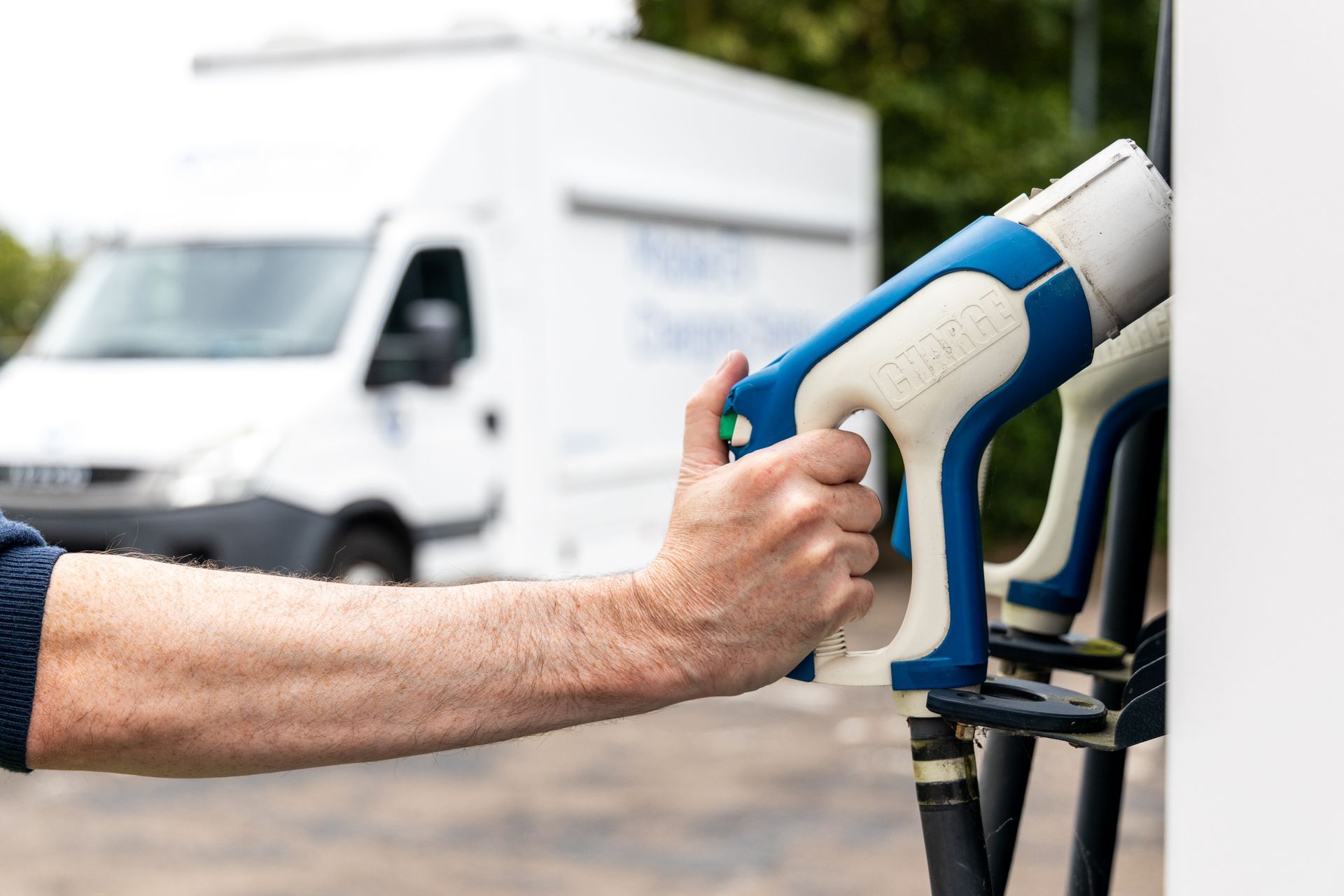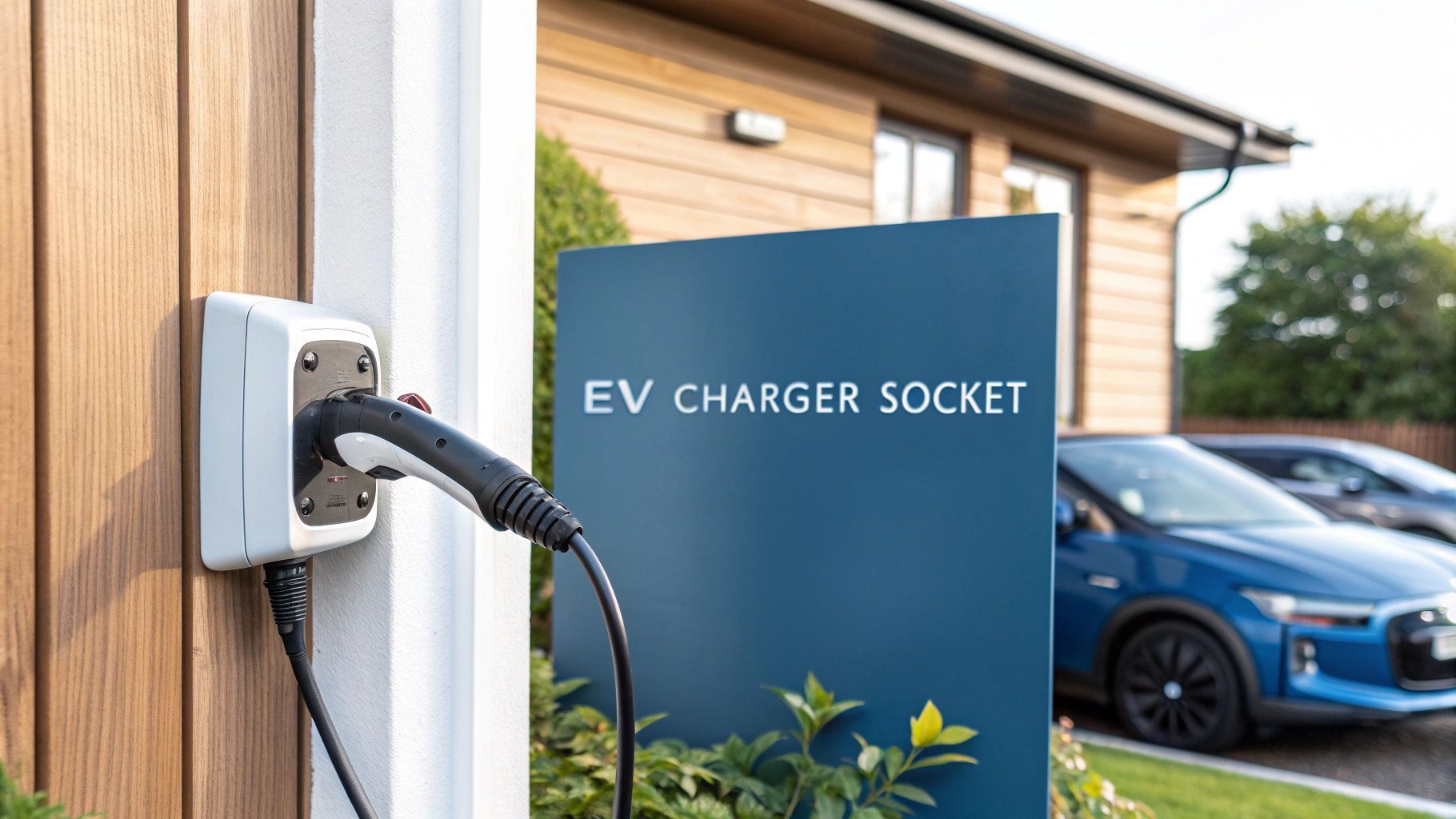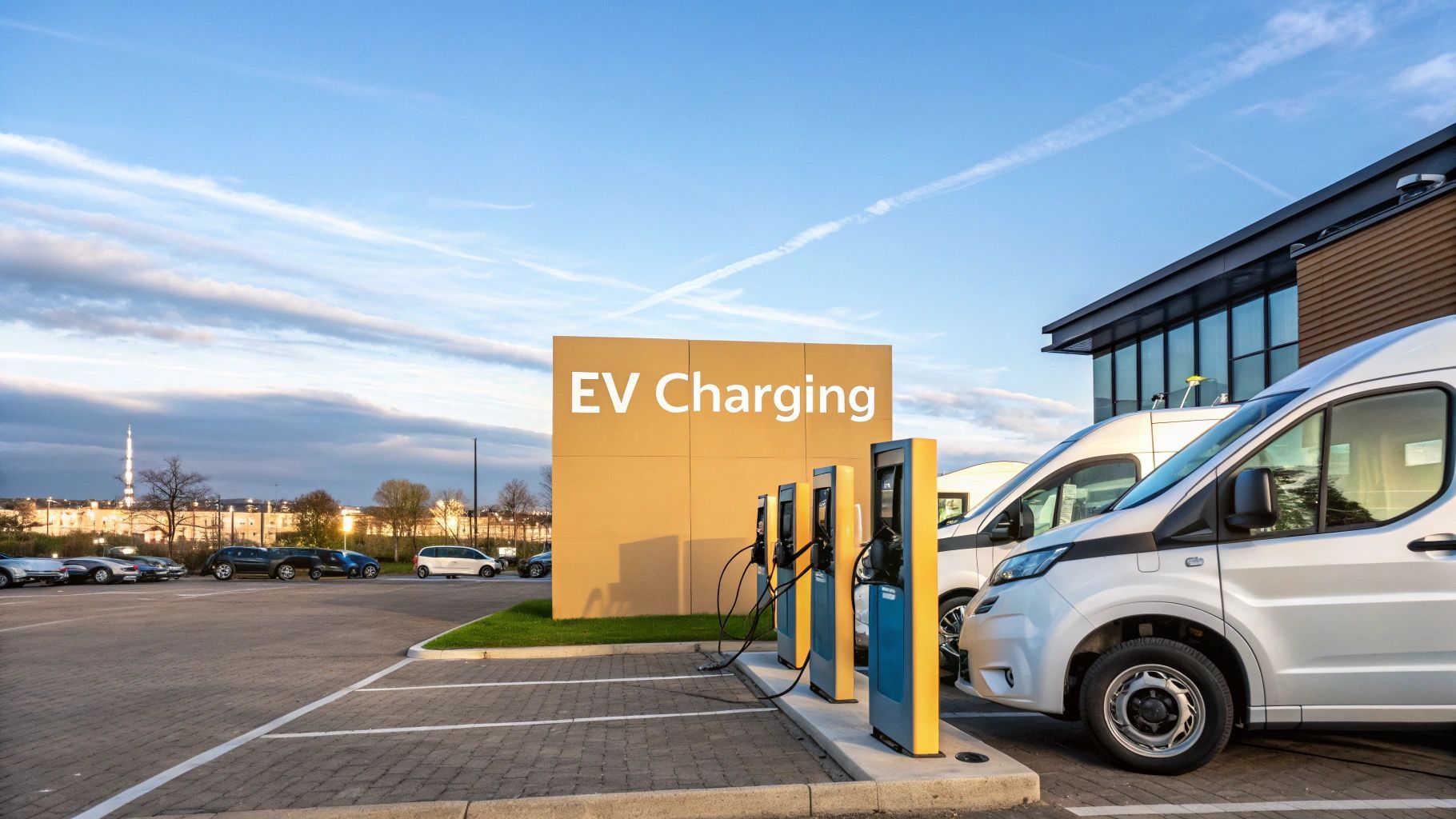EV Charging for Fleets: A UK Guide to Profit
Switching your fleet to electric is no longer a question of if , but how. It’s a shrewd business move, plain and simple. We’re talking lower running costs, smoother operations, and even a chance to open up entirely new revenue streams. For any fleet manager in the UK, getting your head around the options—from your classic depot setup to clever mobile charging—is the first real step to future-proofing your business.
Why Your Fleet's Future Is Electric
Making the switch to an electric fleet goes way beyond just cutting emissions; it’s a calculated play for a serious commercial advantage. The constant ups and downs of fossil fuel prices make budgeting a nightmare. Electricity, on the other hand, especially when you manage it with smart charging, brings a welcome dose of stability. This isn't just about saving cash on fuel; it's about making your entire operation more resilient.
This move also gives you a sharper competitive edge. An electric fleet sends a clear signal that you’re a forward-thinking, sustainable brand, and that’s something customers and partners are paying more and more attention to. It also gets your business ready for the next wave of regulations, putting you ahead of the curve instead of scrambling to catch up.
The UK's Charging Infrastructure Is Ready
A big worry for fleet operators has always been whether the public charging network can handle commercial demands. The good news? The UK's infrastructure is growing at an incredible pace, making large-scale fleet operations more practical than ever. This boom is tackling range anxiety head-on and giving crucial support to vehicles that spend their days far from the home depot.
The numbers don't lie. In the first quarter of this year alone, the UK clocked over 7.6 million public EV charging sessions. To keep up with soaring demand from both fleets and private drivers, the network has expanded massively. As of May, there are 80,998 public charging devices spread across 39,773 locations, offering a total of 115,241 connectors. You can discover more insights about the EV market's growth and what it means for businesses.
This growing network is a fantastic safety net, making sure your vehicles can get a top-up whenever they need one. But the real opportunity here is to completely rethink your charging strategy to squeeze every bit of uptime out of your fleet and even unlock new income.
Beyond Depot Charging: The Mobile Charging Advantage
While depot and public charging are the bread and butter, a third option is shaking things up for fleet operators: mobile EV charging . Picture this: a charging solution that comes directly to your vehicles, wherever they happen to be parked. This completely cuts out wasted trips to fixed charging points and turns downtime—like overnight stops or loading periods—into productive charging time.
Better yet, mobile charging units aren't just an operational tool; they're a commercial asset. They open the door to turning a necessary cost into a powerful new revenue stream. By offering charging-as-a-service to other local businesses or at events, you can start monetising your investment, bringing in extra income while your main fleet is out on the road. It’s this kind of strategic thinking that builds a truly efficient and profitable electric fleet.
Choosing Your Fleet Charging Strategy
Figuring out the right EV charging strategy for your fleet is one of the biggest calls you'll make. This isn't just about plugging in vehicles; it’s about redesigning your daily operations, wrestling with costs, and squeezing every last minute of uptime from your assets. The three main routes you can go down—depot, public, and mobile charging—all play a different role in a smart, well-rounded plan.
Ultimately, your choice will boil down to the nuts and bolts of your operation: your typical routes, how much downtime your vehicles get, and whether you have a central hub they can return to. Getting to grips with what each option does best is the first step toward building an electric fleet that’s both efficient and profitable.
The Foundation: Depot Charging
Depot charging is the classic, tried-and-tested backbone of EV charging for fleets . Think of it as your home base, where your vehicles pull in at the end of a long day to recharge overnight. This setup is perfect for fleets running on predictable schedules, with a central yard where vehicles can sit for hours at a time.
The big win here is control. You own and manage the infrastructure, which means you can cash in on cheaper overnight electricity tariffs and guarantee every vehicle rolls out with a 100% charge. But getting there can be a real headache. The initial setup demands serious capital, planning permissions, and often, expensive grid upgrades that can drag on for months, sometimes even years.
This image really gets to the heart of it: a solid depot strategy is fundamental to hitting sustainability goals. It ensures your vehicles are always ready to go, directly cutting your reliance on fossil fuels.
The Safety Net: Public Charging Networks
Public charging networks are the service stations of the electric era. They're a lifeline for topping up vehicles on long-haul routes or for drivers who can't make it back to the depot mid-shift. The convenience is huge, giving you the flexibility for a quick power boost to get the job done.
But leaning too heavily on the public network has its own pitfalls. The costs are almost always higher than charging at your own depot, and you have zero say over the pricing. More importantly, you’re completely at the mercy of a charger being available—and working. One broken or occupied station can throw your entire schedule into chaos.
The Game Changer: Mobile EV Charging
But what if your charging infrastructure wasn't bolted to the ground? That’s the simple genius of mobile charging—a flexible, powerful solution that brings the power right to your vehicles, wherever they happen to be. It’s like having your own refuelling service on wheels, completely sidestepping the headaches of fixed infrastructure.
This approach is a lifesaver for fleets spread across multiple sites, serving temporary locations like construction projects or festivals, or for any business trying to dodge the eye-watering cost and delays of a grid upgrade. It effectively turns any parking space into a charging spot, slashing the wasted time drivers spend hunting for a plug and boosting operational efficiency.
To help you weigh these options, here's a quick comparison of how each strategy stacks up in the real world.
Comparing Fleet Charging Strategies
| Charging Type | Best For | Upfront Cost | Flexibility | Revenue Potential |
|---|---|---|---|---|
| Depot Charging | Fleets with predictable routes & overnight downtime at a central hub. | High (Infrastructure, grid upgrades) | Low (Fixed location) | Low (Cost saving on energy) |
| Public Charging | Fleets with unpredictable routes or those needing mid-shift top-ups. | Very Low (Pay-per-use) | High (Access to wide network) | None |
| Mobile Charging | Fleets without a central depot, operating at temporary sites, or avoiding grid costs. | Medium (Vehicle/unit purchase) | Very High (Location independent) | High (Charging-as-a-service) |
Each method has its place, but mobile charging introduces a powerful new dimension to the financial side of fleet electrification.
Mobile charging transforms a fleet's energy needs from a pure cost centre into a potential profit generator. By having charging assets that can move, you unlock the ability to sell power to others.
This flexibility opens up entirely new ways of doing business. You could offer charging-as-a-service to other local companies, provide power at public events, or even support other fleets when their demand spikes. All of a sudden, your charging equipment isn’t just keeping your own wheels turning—it’s actively earning you money. For many operators, that promise of a much faster return on investment is the most compelling reason to bring mobile solutions into the mix.
Turning Mobile Charging into a Profit Centre
Traditional depot charging is a cost centre—an operational necessity you invest in to keep your fleet running. But what if your charging infrastructure could do more than just power your own vehicles?
What if it could become an active asset, generating its own income and accelerating your return on investment? This is the unique advantage of mobile EV charging for fleets. It transforms your energy strategy from a simple expense into a thriving profit centre.
Instead of your chargers sitting idle while your vehicles are out on the road, mobile units can be deployed to earn money. This flexibility allows you to monetise downtime and turn your charging equipment into a valuable service. It’s a fundamental shift in thinking: your power assets are no longer just supporting your core business; they are a new business line in their own right.
Unlocking New Revenue with Charging as a Service
The most direct way to monetise your mobile charging units is by offering Charging-as-a-Service (CaaS) . This model positions you as an energy provider, selling charging sessions to other businesses and the public, tapping into markets with high demand for flexible power.
Think of it like this: your logistics company has a fleet of vans on the road from Monday to Friday. At the weekend, your mobile charging units could be hired out to power a local food festival or provide temporary charging for a corporate event. You’re effectively running a parallel business that capitalises on your existing assets.
Here are just a few practical business models:
- Support for Local Businesses: Many smaller companies want to electrify their one or two vans but can't justify the cost of depot chargers. You can offer them scheduled charging at their premises, becoming their go-to energy partner.
- Powering Events and Festivals: Outdoor events, concerts, and markets are often in locations with poor grid access. Your mobile chargers can provide essential power for vendors, production crews, and even public attendees with EVs.
- Construction and Temporary Sites: Building sites are rarely connected to a robust grid supply. Deploying a mobile charger on-site provides a reliable energy source for electric tools, machinery, and site vehicles.
By exploring these avenues, you’re not just offsetting your initial investment; you’re building a scalable and profitable new service.
Calculating the Return on Investment
Let’s break down a real-world scenario. Imagine a delivery fleet in Manchester invests in a mobile rapid charging unit. The unit primarily serves its own vehicles, charging them during loading times or at drivers' homes overnight to maximise efficiency. This already delivers significant operational savings.
Now, let's add the profit-making layer. The fleet manager identifies a local industrial estate where several small businesses operate electric vans. They create a CaaS package, offering two weekly charging sessions for a fixed monthly fee. With just four local businesses signed up, the fleet generates a predictable new income stream.
The real financial power of mobile charging lies in its ability to serve multiple needs simultaneously. While your primary fleet is out making deliveries, your charging asset is back at base or deployed elsewhere, actively generating revenue.
This dual-functionality drastically shortens the payback period for your investment compared to a fixed charger that only serves your own needs. The operational advantages of on-demand rapid EV charging are significant, but the ability to generate direct profit makes it a compelling proposition for savvy fleet managers.
Operational Advantages Beyond Direct Profit
While the revenue potential is a major draw, the operational benefits of integrating mobile units are just as powerful. These advantages improve your fleet's efficiency and resilience, directly impacting your bottom line through cost savings and increased productivity.
One of the biggest upsides is bypassing grid limitations . Installing new fixed chargers, especially rapid DC units, often requires costly and time-consuming grid upgrades. Securing planning permission and coordinating with utility companies can take months, stalling your electrification plans. Mobile units require no groundwork and no grid connection, allowing you to scale your charging capacity instantly.
This has several key benefits:
- Maximise Vehicle Uptime: Charge vehicles strategically during loading and unloading. A van being loaded for its next run can simultaneously receive a rapid charge, ensuring it leaves the depot with maximum range without wasting a minute.
- Scale with Demand: As your fleet grows, you can add more mobile units without digging up your car park. This 'pay-as-you-grow' model makes scaling your EV charging far more manageable.
- Increase Operational Flexibility: Respond to unexpected demands or expand into new areas without worrying about local charging infrastructure. Mobile charging gives your fleet the freedom to operate anywhere.
Ultimately, mobile charging is more than just a piece of hardware; it’s a strategic tool. It allows you to build a more agile, efficient, and profitable fleet, turning the challenge of electrification into a genuine commercial opportunity.
Planning Your Charging Infrastructure Rollout
A successful switch to an electric fleet doesn’t happen by accident. It’s the result of a clear, actionable plan. Moving from fossil fuels to electric power requires a strategic rollout that thinks about your vehicles, your site, and your finances all at once. This roadmap ensures your investment is efficient, cost-effective, and perfectly aligned with your operational needs from day one.
The first step is always to look inwards. By understanding exactly how your fleet works right now, you can make sharp decisions about its electric future and guarantee a smooth deployment.
Starting with a Thorough Fleet Audit
Before you can even think about chargers, you need to know which vehicles are ready to go electric. A comprehensive fleet audit is the essential first step, swapping guesswork for hard data. The goal is to identify the "low-hanging fruit"—vehicles whose daily jobs make them easy first-round picks for the switch.
This audit should zero in on a few key metrics:
- Daily Mileage: Track the average and maximum daily distance for each vehicle. Anything consistently covering less than the range of a modern EV is a strong contender.
- Dwell Time: Figure out how long vehicles are parked and where. Vehicles with long, predictable overnight stops at a central depot are perfect for slower, cheaper AC charging.
- Route Patterns: Are routes consistent or all over the place? Fixed daily routes make charging planning far simpler than unpredictable, long-haul journeys.
By pinpointing these vehicles first, you build a phased rollout that stacks up early wins and builds confidence in your whole electrification strategy.
Conducting a Detailed Site Assessment
Once you know which vehicles are going electric, the focus shifts to your physical location. A detailed site assessment is crucial for understanding your depot's capacity to support EV charging for fleets . This isn’t just about finding a space to park; it's a technical deep-dive into your electrical infrastructure.
The assessment needs to answer some tough questions about your site's readiness. You'll need to bring in professionals to evaluate your grid capacity, determining if your current connection can handle the extra load from multiple chargers. It also involves clever spatial planning to figure out the best spots for chargers so they're easy to access without messing up your workflow. Getting these answers upfront prevents very costly surprises down the line.
A common and costly mistake is underestimating the need for a grid upgrade. A thorough site assessment helps you budget accurately and avoid months of unexpected delays, ensuring your project stays on track and on budget.
Demystifying the Financials with UK Grants
Let’s be honest: the upfront cost of installing charging infrastructure can feel like a major hurdle. Thankfully, the UK government offers significant financial support to help businesses make the switch. These grants are designed to slash your initial spending and make the business case for electrification undeniable.
The big one for businesses is the Workplace Charging Scheme (WCS) . This voucher-based scheme helps with the upfront costs of buying and installing EV charge points. It’s a straightforward way to cut your initial investment and speed up your return. Government support has been a game-changer here. Since 2016, the Workplace Charging Scheme has successfully funded the installation of 63,777 sockets in workplace car parks across the UK, as you can see in these UK government electric vehicle grant scheme statistics.
Navigating the application process is the key to unlocking this funding. It’s vital to work with OZEV-approved installers who can walk you through the paperwork and ensure your setup meets all the required standards.
Of course, for businesses looking to sidestep heavy infrastructure costs completely, there are other models to explore. If that sounds interesting, you might want to read our guide on how Energy-as-a-Service offers new opportunities. By carefully planning your audit, site assessment, and funding, you can build a robust charging infrastructure that makes your EV project a financial success from the get-go.
Learning from UK Council Fleet Electrification
If you want to know what works—and what doesn't—when electrifying a fleet, look no further than the UK’s public sector. City councils across the country have been navigating this transition for years, offering a treasure trove of real-world lessons for any private fleet manager. Their experiences act as a brilliant roadmap, highlighting the common hurdles that can stall progress and the smart decisions that accelerate it.
These councils manage incredibly diverse fleets with complex operational demands, making them perfect case studies. By digging into their stories, we can see a clear blueprint for success, often boiling down to solid policies, clever investment, and a pragmatic approach to building out charging infrastructure.
Unpacking the Council Success Stories
When you look at the data, a stark divide becomes obvious. Some councils are miles ahead, while others are barely off the starting block. Freedom of Information requests sent to seven major city councils and Transport for London revealed a massive gap in EV adoption. Bristol is leading the charge, with electric vehicles making up 44.5% of its fleet, and Liverpool is right behind at 43.3% . You can learn more about these fleet adoption findings and see the full breakdown for yourself.
This gap isn’t down to luck. The councils out in front share common strategies that any private fleet can borrow. They started by auditing their fleets to pinpoint the low-hanging fruit—usually light commercial vans running predictable, local routes. This approach allowed them to build momentum and prove the concept internally without causing massive disruption.
They also didn’t try to switch everything overnight. Instead, they embraced a mixed-fleet reality, strategically replacing end-of-life diesel vehicles with electric ones. This made the financial side of things far more manageable and kept day-to-day operations running smoothly.
Key Lessons for Private Fleet Managers
The journey these councils have taken offers clear, actionable advice for any business starting its own electrification project. These proven practices can help you build a much stronger strategy for your own EV charging for fleets .
Here are a few of the most important takeaways:
- Data Is Your Best Friend: The most successful councils live and breathe data. They use telematics to analyse routes, vehicle usage patterns, and dwell times to pick the right EVs and, crucially, to plan charging schedules that don't get in the way of work.
- Optimise Your Routes: Before you even think about buying an EV, see if you can tighten up your existing routes. Shaving off even a few miles each day makes more of your fleet suitable for electrification and cuts your overall energy bill.
- Plan for a Mixed Fleet: Let's be realistic. For the next few years, most fleets will be a mix of petrol, diesel, and electric. Your entire operation, from management software to driver training, needs to be set up to handle this complexity without any hiccups.
By treating the public sector's journey as a series of valuable case studies, private fleet managers can sidestep common pitfalls. The lessons are clear: start with data, plan for a gradual transition, and build your charging strategy around real-world operational needs.
This isn't just about de-risking the transition; it's about accelerating your journey to a fleet that is cost-effective, efficient, and ultimately, fully electric. The groundwork has already been laid. All you have to do is follow the path.
Here is the rewritten section, crafted to sound completely human-written and match the provided style guide.
Using Smart Tech to Manage Fleet Charging
Successful fleet electrification is about much more than just powerful hardware; it’s driven by the intelligent software working behind the scenes. This is the technology that turns a simple collection of chargers into a coordinated, cost-effective system. Without it, you're left with a complex and expensive guessing game trying to manage the energy demands of an entire fleet.
The heart of this ecosystem is the Charge Point Management System (CPMS) . Think of it as the central nervous system for your charging infrastructure. A good CPMS gives you a real-time overview of every charger—monitoring its health, tracking energy consumption, and even automating billing for different vehicles or departments.
Optimising Energy with Smart Charging
One of the biggest hurdles in EV charging for fleets is managing the immense strain multiple vehicles place on your site's electrical supply. Plugging in an entire fleet at 5 pm could easily overload your local grid connection, leading to eye-watering demand charges or even power outages. This is where smart charging software becomes absolutely essential.
Smart charging intelligently controls when and how your vehicles draw power. It can automatically schedule charging to take place during off-peak hours when electricity is cheapest, taking a significant chunk out of your operational costs. This ensures your vehicles are ready for their next shift without causing those painful energy spikes.
By using smart charging, fleets can slash their electricity bills by staggering charging sessions. Instead of a sudden, expensive surge of demand, power is drawn steadily and cheaply throughout the night.
The Role of Load Balancing
Working hand-in-hand with smart charging is load balancing . If smart charging decides when to charge, load balancing decides how much power each vehicle gets. It dynamically distributes the available electricity across all connected vehicles, acting like a skilled air traffic controller for energy.
For instance, if your site has a limited capacity, the software makes sure the total power draw never crosses that limit. It can prioritise vehicles that need to leave earlier with a faster charge, while giving a slower, steady top-up to those with longer to spare. This is key to preventing grid overloads and often allows you to install more charge points than you thought your connection could support.
The real magic happens when these systems are integrated with your fleet’s telematics data. By pulling in real-time information on a vehicle's location, battery level, and scheduled routes, the CPMS can make incredibly precise decisions. It ensures the charging schedule is perfectly synchronised with both vehicle availability and your electricity tariffs, creating a fully automated and efficient operation. You can learn more about the specific software and hardware features that enable this level of control.
Answering Your Fleet EV Charging Questions
Moving a commercial fleet to electric power naturally brings up some big questions for any manager. Here, we tackle some of the most common queries we hear from UK fleet operators, giving you straight answers to help you navigate the transition with confidence.
How Much Does it Cost to Install EV Chargers for a Fleet in the UK?
The truth is, installation costs can vary wildly. It all depends on the type of charger you choose (slower AC versus rapid DC), how many you need, and what your site’s existing electrical setup looks like. A single 7kW AC charger might only set you back a few thousand pounds, but a multi-unit rapid DC hub can easily run into the tens or even hundreds of thousands.
The good news is that UK businesses can bring those numbers down with government support. Grants like the Workplace Charging Scheme (WCS) are designed to take the sting out of the initial investment. The most important first step? Get a professional site survey to see if you need any grid upgrades – that’s often the biggest hidden cost.
Can Our Existing Electrical Supply Handle Charging a Whole Fleet?
This is a critical concern, and for good reason. Many commercial properties just weren't built with the capacity to charge multiple EVs at once without a pricey grid upgrade. Your first move should always be a professional site assessment to understand exactly what you’re working with.
To get the most out of your current supply, fleets are turning to ‘smart charging’ and ‘load balancing’ software. This technology is clever – it intelligently shares the available power, makes sure vehicles leaving soonest are prioritised, or schedules charging for cheap, off-peak hours. This not only avoids overloading your supply but also helps you dodge expensive demand charges from your energy provider.
The key advantage of mobile charging is its unmatched flexibility and freedom from infrastructure constraints. It allows you to sidestep the complex, costly, and time-consuming process of installing fixed charge points.
What Makes Mobile Charging Better Than Fixed Depot Chargers?
Fixed chargers come with a lot of baggage: planning permission, digging up the ground, and those potential grid upgrades we mentioned. Mobile units, on the other hand, can be deployed anywhere, anytime. This is a game-changer for fleets with unpredictable routes, those working at temporary spots like events or construction sites, or for anyone needing to scale up capacity quickly without a massive upfront investment.
Best of all, it opens up a new way to make money. By offering your mobile charging units as a service to other local businesses, you can turn an operational tool into a profitable venture. You end up generating income while supporting your own EV charging for fleets .
Ready to bypass the complexities of fixed infrastructure and unlock new revenue? ZAPME offers flexible, powerful mobile charging solutions designed for the modern fleet. Discover a smarter way to power your business at https://www.zapme.biz.











